Battling Birds
Falconer Chases Gulls from Downtown Trash Facility
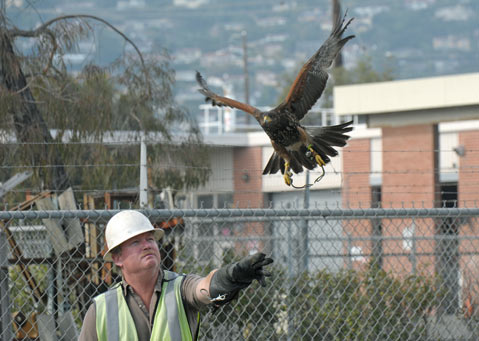
For commercial operations generating more than a few dumpster loads of trash a week, having a falconer on the payroll has become almost an obligatory fashion statement. Any winery worth its appellation has at least one large raptor it can call on, and franchises like Disneyland and Sea World deploy winged armadas to keep airborne scavengers at bay. Cottage Hospital uses a raptor to keep its pigeon population in line. And the county’s coastal landfill at Tajiguas famously solved what seemed like an insoluble water contamination problem by hiring a falcon to chase away the gulls who let loose their flying fecal material — on an industrial scale abundance — into nearby creeks.
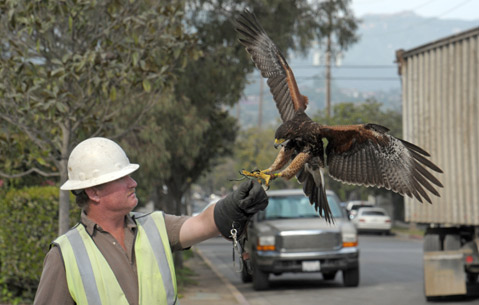
Little wonder, then, that the airspace above MarBorg’s vast trash warehouse on Santa Barbara’s industrial east side — where millions of tons of construction and demolition (C&D) debris are processed each year — are now patrolled by a 14-month-old Harris’s hawk named Gillian.
Gillian and her handler, full-time falconer Gary Bauer, are the one-two punch making the neighborhood a lot less hospitable to seagulls for the past two years. “All birds have an innate fear of raptors,” explained Bauer. When the gulls see Gillian take to the air, it makes them “apprehensive.” Accordingly, he said, “they go someplace else.”
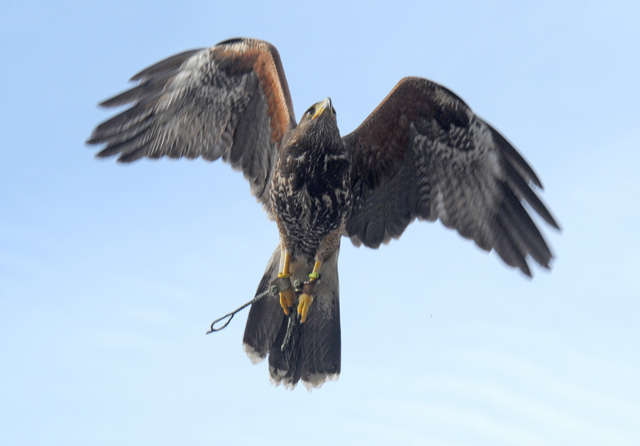
Bauer and his boss — MarBorg executive Brian Borgatello — take pains to stress that Gillian is programmed not to kill the gulls — this is Santa Barbara, after all, where animal welfare is always paramount — just to chase them away. “People sometimes ask, ‘How many birds did it kill today?’” Borgatello said. “Our answer is always the same: ‘It hasn’t killed any today, and it never has.’” The gulls, however, are not aware of the political considerations that cause Gillian to pull her punches. “Once I let her go,” Bauer said of his hawk, “it’s a life-and-death situation, and the gulls take that very seriously.”
The results, according to Borgatello, have been both obvious and immediate. “We’ve see a great reduction in the number of gulls visiting the buffet across the street,” he said, pointing to the C&D plant. While such facilities typically process the remains of old buildings and chopped-down trees, it’s not uncommon for food scraps and other comestibles to be tossed into the roll-off boxes that are tipped inside MarBorg’s Quarantina Street plant each day. In the argot of the trash industry, such garbage is known as “putrescibles.”
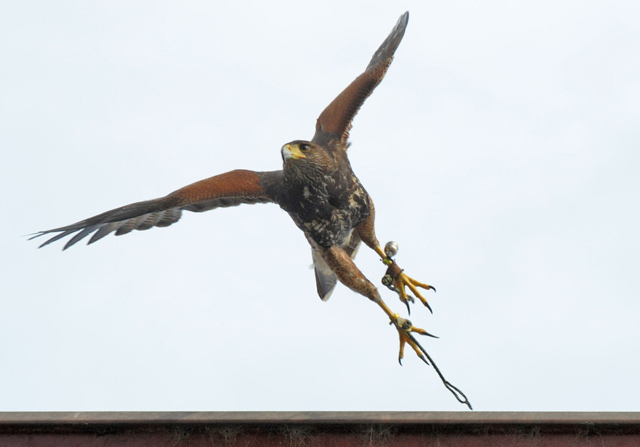
MarBorg’s raptor patrol is now two years old. For all but six months of that, Bauer has been the walking the seagull sentry, leashed hawk prominently perched on his protective falconer’s glove. For Bauer, a onetime pet shop owner and farmer from Lompoc, it’s been the conversion of a hobby into a career. Where others went hunting with guns or bows, he’d take the woods armed with a bird.
Although he now owns four raptors, he’s quick to point out they should never be mistaken for pets. “These are not social birds like some parrots,” he explained. Bauer bought Gillian when she was about five months old. Prior to that, the hawk, he said, had been “chamber raised,” meaning it grew up with its extended family. After three months of training, he said, he could “fly” the bird. After another three or four, Gillian was prepared for patrol. Compared to peregrine falcons, Harris’s hawks are incredibly slow, zooming through the air at a paltry 50-60 miles an hour as opposed to the peregrine’s fabled descents of 200 mph. Unlike peregrines — which easily achieve heights of 1,000 feet — Harris’s hawks will find the top of a telephone pole or tall tree on which to perch. The good news is that they’re not prone to the peregrine’s great sweeping flights, meaning they tend not get as distracted or lost along the way.
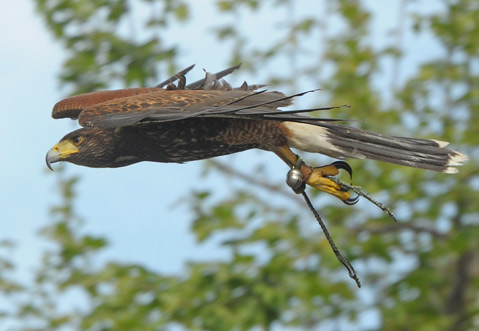
Gillian may be top of the aeronautic food chain, but there are still challenges and threats. Other birds of prey, like red-tailed hawks, are common to these parts. And trucks and telephone wires can do more than merely clip a bird’s wings. And not all seagulls are willing to go quietly into Gillian’s good night; some alpha gulls are known to put up resistance.
This time of year is relatively quiet. It’s mating season for the seagulls, so much of the population is now happily distracted by the business of propagating the species relatively far away on Santa Cruz Island. But, as Bauer noted, there are many subspecies to the gull population, and it’s his business to know difference between migratory gulls just passing through and the local population for whom Santa Barbara has been home for many millennia.
Bauer noted that the gulls study him and Gillian as avidly as he studies the gulls. They track his whereabouts and his patterns, he said, and react accordingly. Bauer isn’t brimming over with kind words about the gulls. But, he added, “They’re a lot smarter than people think.”



